|
Additional Lessons |
 About These
Lessons About These
Lessons
The following classroom lessons are great for students
who want additional listening and reading practice. |
-
Travel America -
Beginner
Level. Do you love America and American
English? Learn before you travel. Facts and other
cool stuff about your favorite U.S. state. Great
English reading practice.
|
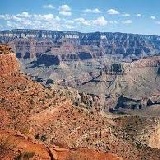 Travel
America - Nebraska Travel
America - Nebraska
(Beginner -
Reading)
Learn some interesting facts and read interesting
stories about Nebraska. |
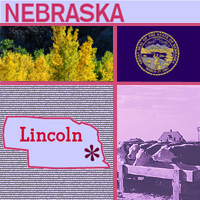 Nebraska Nebraska
Nebraska gets its name from an Indian word meaning
"flat water" after the Platte River that flows
through the state. The Nebraska Territory was formed
in 1854 at the same time as the Kansas Territory.
Nebraska was admitted into the Union in 1867 as the
37th state. Its nickname, "Cornhusker State," refers
to the way that corn (a leading product of the
state) was commonly harvested, "husking" it by hand,
before the invention of husking machinery. Another
nickname, the "Beef State," refers to one of
Nebraska's main industries, cattle. Omaha has been a
major meatpacking center since the 1880s. Although
Omaha was the territorial capital, Lincoln, named in
honor of the 16th president, is the state capital.
The flower is the goldenrod. |
Nebraska
State Flag
Nebraska was one of the last states to adopt a state
flag. Representative J. Lloyd McMaster introduced a bill in
1925 to designate a state banner and the bill was passed.
The law describes the banner as: "... a reproduction of the
Great Seal of the State charged on the center in gold and
silver on a field of national blue."
In 1963 the Legislature finally designated the state banner
as the official flag of Nebraska. The symbols on the great
seal of Nebraska are described on a bill introduced in 1867:
"The eastern part of the circle to be represented by a
steamboat ascending the Missouri River, the mechanic arts to
be represented by a smith with a hammer and anvil, in the
foreground, agriculture to be represented by a settlers
cabin, sheaves of wheat, and stalks of growing corn, in the
background a train of cars heading towards the Rocky
Mountains, and on the extreme west, the Rocky Mountains to
be plainly in view, around the top of the circle, to be in
capital letters, the motto: "Equality Before the Law," and
the circle to be surrounded with the words, "Great Seal of
the State of Nebraska."
The Great Seal of Nebraska is protected by state law
(graphic images of the state seal are not in the public
domain). The restrictions on the use of the state seal also
apply to Nebraska's state flag (the state seal is the flag's
centerpiece). Requests for permission to use images of the
Nebraska state seal or state flag must be made in writing to
the Secretary of State.
Neither this website, nor the information presented on this
website is endorsed by the state of Nebraska or Nebraska's
Secretary of State. |
|
Source:
State Symbols USA |
|
|
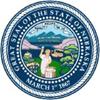 Nebraska
State Facts Nebraska
State Facts
Picture: state seal of Nebraska |
|
State Capital |
Lincoln |
|
Nickname |
Cornhusker State |
|
Motto |
Equality before the law |
|
Statehood |
March 1, 1867 (37th) |
|
Origin of Name |
Based on an Otos Indian word that means "flat
water," referring to the Platte River |
|
Largest Cities |
Omaha, Lincoln, Grand Island, Bellevue, Kearney |
|
Border States |
Colorado, Iowa, Kansas, Missouri, South Dakota,
Wyoming |
|
Area |
78,878 sq.mi., 15th largest |
|
State Bird |
Western Meadowlark |
|
State Flower |
Goldenrod (solidago) |
|
State Tree |
Eastern Cottonwood (populus deltoides) |
|
State Song |
Beautiful Nebraska |
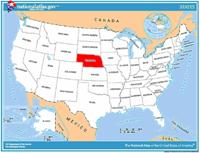 Travel and tourism
site for Nebraska - This state travel and territorial
tourism site provides ideas for your vacations, meetings, and more. Travel and tourism
site for Nebraska - This state travel and territorial
tourism site provides ideas for your vacations, meetings, and more. |
|
|
Nebraska Stories |
|
|
Jacob Friesen and the Blizzard of 1888
How much do you know about your local history? The fourth-graders at
the Heartland Community School in Henderson, Nebraska, researched
their local history and discovered a hero.
On January 12, 1888, a huge blizzard suddenly hit the state of
Nebraska. A fierce northwest wind blew and the temperature fell to
40 degrees below zero in some places! The storm lasted a long time
-- 12 to 18 hours. In those days, there weren't any radios or
televisions to warn people about severe weather, so everyone was
caught off-guard.
That afternoon, three of Jacob and Anna Friesen's children went to
visit their older brother a mile and a half away. Later that day,
when the blizzard hit, the children decided they had better go home.
The blizzard was so harsh that it blinded them. They got lost and
ended up digging themselves into a haystack just to keep warm.
Meanwhile, their parents were worried about them. Their mother
placed a lamp in the window and hoped they would see it and find
their way home. Finally, their father went out to find the children.
He followed along a barbed wire fence for a half a mile and then
started calling their names. Luckily, the haystack was close enough
that the children could hear him, and they all found each other.
They followed the fence back to the farm and then could see their
way safely to the house because of the light in the window. No doubt
the children knew their dad was a hero that night.
Why not do some research into your local history? You just might
find a hero, too. |
|
|
Boys Town
You may have heard of Boys Town, but do you know what it is?
In 1917, a priest named Father Flanagan decided to help homeless
boys by establishing the community of Boys Town near Omaha,
Nebraska. It became a village in 1936. Boys Town continues to help
homeless and troubled kids and now has a farm, churches, and a
campus where children attend classes. The children themselves govern
Boys Town. In fact, they recently voted to change the village's name
to Boys and Girls Town, because girls also attend. In 1991, they
elected their first female mayor, 12 years after the first girls
arrived.
For many years, the symbol for Boys Town has been that of a boy
carrying a younger boy. This image comes from an event that Father
Flanagan witnessed. One summer day, some of the boys from Boys Town
decided to go swimming. One little boy was upset that he couldn't go
because he had a brace on his leg and couldn't walk easily. But a
boy named Jim Edwards picked him up and started to carry him on his
back. Father Flanagan encouraged the other boys to help, but Jim
said to the priest, "He ain't heavy, Father, he's my brother."
Father Flanagan was very moved by what Jim said and told all the
boys about it. He used the story to point out, "Always take care of
your fellow men."
|
|
|
A Celebration of Nebraska Mexican Heritage
What traditions does your family have that you'd want to pass along
to others? It could be a recipe for a dish you really like to eat,
or an activity that you do every year with your relatives.
Between 1900 and 1930, thousands of Mexicans arrived in Midwestern
states such as Nebraska. Many came to find jobs in the United States
and seek a better life. During the 1990s, the Nebraska State
Historical Society started the Mexican American Traditions in
Nebraska project to help collect and preserve the history of Mexican
Americans in the state. As part of the project, Mexican American
volunteers interviewed traditional artists, musicians, and older
community members about their history, culture, and traditions.
One example was a woman from Scottsbluff, Nebraska, who told how her
father, who was ill and unable to get out of bed, was still able to
teach her traditional dances. Her father had a vertical board placed
against his feet, and he "sounded out" the steps. His daughter would
repeat the steps until they sounded right. Once she learned the
dances, her father asked her to promise to teach others. She formed
a dance group and she made dresses in the style of her father's
birthplace in Mexico. Now many people are able to share in this
tradition. |
|
|
Joslyn Art Museum: Jazz on the Green
The man in the photo is playing a vibraphone. Do you know what that
is?
A vibraphone is a jazz instrument that was invented around 1920.
It's a percussion instrument, so a musician must beat or strike it
to make sounds. It looks a little like a xylophone and has tuned
metal bars that a player hits with felt or wool beaters. Striking
the bars makes a soft, mellow sound. Underneath the bars are
"resonators," which add vibration to the sounds that are made. In
addition, small electric fans between the bars and the resonators
cause a vibrato, or trembling effect. These fans are what give the
instrument its name.
Thousands of people can listen to a vibraphone as they enjoy jazz
music every summer at the Joslyn Art Museum in Omaha, Nebraska. Jazz
was invented by African American musicians in New Orleans,
Louisiana, and Kansas City, Missouri, and other cities in the late
19th and early 20th centuries. What makes it different from other
music is something called improvisation. Usually a composer writes
music and a musician plays it exactly as it was written. With jazz,
the musicians start with a song but then improvise, or start making
music up as they go along. That is why many jazz songs never sound
the same way twice. |
|
|
Nebraskaland Days
The man in the photo is about to be thrown off his horse. He is
trying very hard to stay on a bucking bronc -- a horse that hasn't
been "broken," or made suitable for riding. Bareback bronc riding is
an event at the Buffalo Bill Rodeo during a celebration of Nebraskan
culture called Nebraskaland Days in North Platte. The idea for the
Buffalo Bill Rodeo came from the man himself, Buffalo Bill.
Buffalo Bill was born William Frederick Cody in Iowa in 1846. He
became famous for his adventures as a scout and hunter in the West.
On the Fourth of July in 1882, Buffalo Bill held an "Old Glory
Blowout" in North Platte, Nebraska. It included buffalo riding,
bucking bronc riding, steer roping, and horse racing. The town of
North Platte claims it as the first rodeo ever held. The show also
had a buffalo hunt and events in which people re-enacted, or
demonstrated, battles. The "Old Glory Blowout" was such a success
that Buffalo Bill took the show, known as "Buffalo Bill's Wild
West," on the road throughout the United States and even to Europe.
The Wild West show made him world famous, and he toured with it
until 1916. Today, the Buffalo Bill Rodeo and Nebraskaland Days is
the modern-day version of Buffalo Bill's Wild West show.
You can read more about Buffalo Bill in the "Amazing Americans"
section of this Web site. |
|
|
Winnebago Powwow
Have you ever been to a powwow? If you went to Winnebago, Nebraska,
in July, you'd have a chance.
For five days every July, the Ho-Chunk people hold a powwow in
Winnebago. A powwow is an Indian social gathering that usually
includes dance and music. The Ho-Chunk Nation is a group of Indians,
also known as the Winnebago, who originally lived in the Wisconsin
area. They farmed and hunted bison. Beginning in the early 19th
century, the United States government forced the Ho-Chunk to give up
portions of their land, and they were moved to Iowa in 1840. For the
next 25 years, the U.S. government made the Ho-Chunk move again and
again, from Iowa to Minnesota to South Dakota. Finally, they were
allowed to settle in Nebraska, though many eventually returned to
Wisconsin.
The Ho-Chunk's annual powwow in Winnebago is held to honor their
last war chief, Little Priest. After the Ho-Chunk moved to Nebraska,
a group of them, including Little Priest, enlisted in the Army and
served in a local unit. In 1866, Little Priest died from wounds he
received while in the Army. Today, the powwow remembers his
sacrifice and honors all Winnebago war veterans. |
|
|
The Omaha Indians in Nebraska
Hundreds of years ago, the Omaha Indians lived in the middle and
south Atlantic regions of the United States. They gradually migrated
west with other Plains Indians until they split off in South Dakota
and ended up in what is now Nebraska. In 1854 the Omaha tribe gave
way to the pressure of incoming white settlers and sold the majority
of the land they held to the U.S. government. Today, the Omaha
Reservation is located in the northeastern corner of Nebraska on
31,148 acres.
The Omaha were traditionally farmers and hunters. Their structured
class system included chiefs, priests, physicians, and commoners.
Groups with common goals and duties -- called clans -- performed
various functions for the tribe. The earth clan was responsible for
ceremonies of war and food, and the sky clan was responsible for
ceremonies relating to the supernatural. Today, music and oral
tradition play important roles in the preservation and perpetuation
of Omaha culture. The state's largest city, Omaha, is named after
the tribe. |
|
Source:
Library of Congress |
|
 National
Forests and Monuments of Nebraska National
Forests and Monuments of Nebraska
The following is a description of national
forests and monuments in the state
of Nebraska. There are no national parks in
this state. If you plan to visit or live in
Nebraska for awhile then you should
definitely plan to visit some of these
fantastic places. |
|
|
|
National Forests |
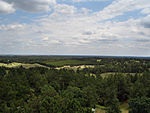 Nebraska Nebraska
This forest was created in 1902 by Charles
E. Bessey as an experiment to see if a
forest could be created in treeless areas of
the Great Plains for use as a national
timber reserve. The Bessey Nursery is
located in the northwest corner of the
forest's Bessey Ranger District. |
 Samuel
R. McKelvie Samuel
R. McKelvie
Located in the Sandhills of Nebraska, Samuel
R. McKelvie National Forest is a combination
of prairie and trees planted since 1903, of
which ponderosa pine has been most
successful. |
|
|
|
National Monuments |
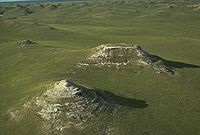 Agate
Fossil Beds Agate
Fossil Beds
The valley of the Niobrara River is known
for its large number of well-preserved
Miocene mammal fossils which date from about
20 million years ago. |
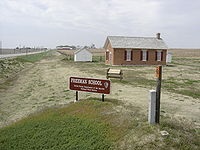 Homestead Homestead
Daniel Freeman's homestead was recognized by
the United States Congress as the first
homestead in the nation obtained through the
Homestead Act of 1862. The monument contains
a visitor center, a tract of tallgrass
prairie, and the Freeman School. |
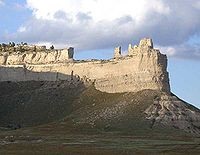 Scotts
Bluff Scotts
Bluff
Scotts Bluff is an important 19th century
geologic formation and landmark on the
Oregon Trail and Mormon Trail. It contains
multiple bluffs on the south side of the
North Platte River, but it is named after a
prominent bluff called Scotts Bluff which
rises more than 830 feet (250 m) above the
plains at its highest point. The monument is
composed of five rock formations named Crown
Rock, Dome Rock, Eagle Rock, Saddle Rock,
and Sentinel Rock. |
|
|
|
 Travel
America Travel
America
Do you love America and American English? Learn before
you travel. Facts and other cool stuff about your
favorite U.S. state. Visit the Fun Easy English Travel
America pages. Read about the beautiful National
Forests, Parks, and Monuments. Great English reading practice. |
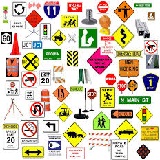 Drive America Drive America
Planning to drive in America? Learn the rules and
regulations. Great English reading practice. |
|